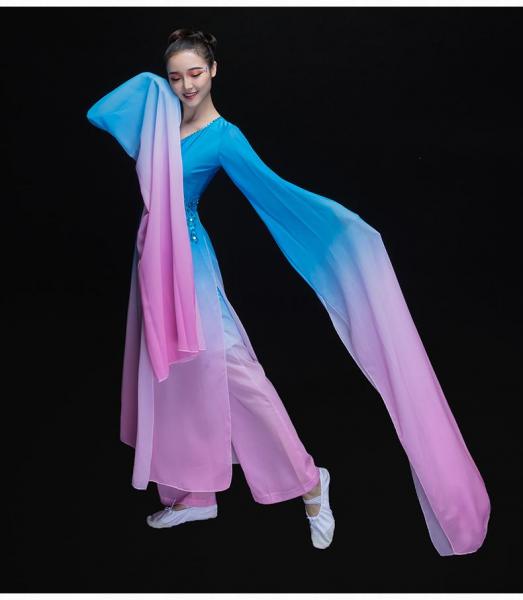Chinese Traditional Dance
The Chinese national dance culture has a long history. The track record of text cultural relics and images of the traditional Chinese dance is never extinguished during the past 5,000 years' history. This phenomenon is also rare in the culture history of the world.
What is traditional Chinese dance – the main characteristics?
The group characteristics of Chinese traditional dance mainly express in three aspects: the creation, the performance, and the spread, and is a perfect combination of song, music and dance. Chinese traditional dance come from the folk. Added gradually with the rapid movement, the harmony step and the unified rhythm, the Chinese traditional dance expresses the folks` need of emotion release in the way of pleasure, anger, sorrow and joy.
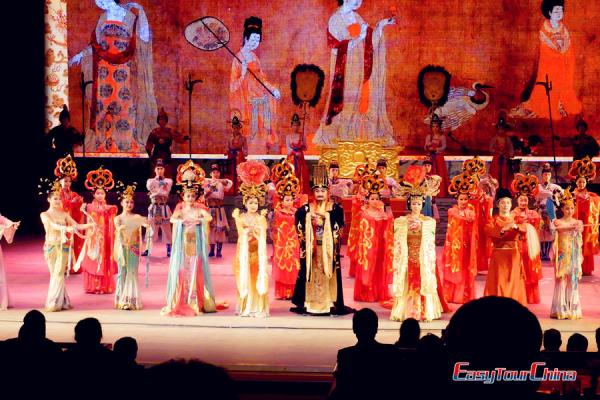
Chinese traditional dance history
About five or six thousand years ago, in the Neolithic age, the Chinese showed the groupment and self-entertainment of the original dance. In order to maintain and continue their life, human must create material wealth and spirit wealth through labor. So, working is the most basic and important social activities of human beings. Deeply rooted in the daily life of human, the dance must reflect the content of labor and reproduction.
Prehistoric Chinese dance originated from religion. Shamanist performs various religious ritual involving dances. Ancient dance was merely a religious ritual rather than a form of entertainment art. A five-string musical instrument named Se (瑟) and bone flute was created and played earliest Chinese traditional dance music.
During Zhou dynasty, there was great development of Chinese dance in the form of rites and large-scale royal religious ceremony. The dance was known as “Yue Wu” accompanied by music performance known as “Ya Yue”. There are two particular schools of dance, known as “Big Dance” and “Small Dance”. During Han dynasty, there were greater developments of dance as forms of entertainment. Professional training and the innovation of new gadgets used for dance were created. The Tang dynasty saw another peak development in Chinese dance. Tang dynasty dance was built on the foundation of the Han dynasty’s “Hundred performance” and a blend between foreign and Chinese culture during Age of fragmentation. With Xian’sTang Dynasty Music and Dance performance, people can glimpse into the beautiful dance at that time.
After Song dynasty, traditional Chinese folks dance began to rise up as the more popular dance. Various ancient dances began to disappear. The development of opera-dance as a form of entertainment during Yuan dynasty began to take toot. By Ming and Qing dynasty, opera dance became a mature form of entertainment art. By ROC and PRC period, musicals dance became a popular form of entertainment performance.
Some famous forms and styles of Chinese traditional dance:
Dragon Dance
The Chinese people often call themselves the "descendants of the dragon". The dragon is an intentional animal created by Chinese ancestors. It is a symbol of divine power and good fortune. Its shape is a combination of the totem shapes of many peoples. It shows that in ancient times, different clans on the land of China created the image of the dragon in the process of continuous union, merger and integration.
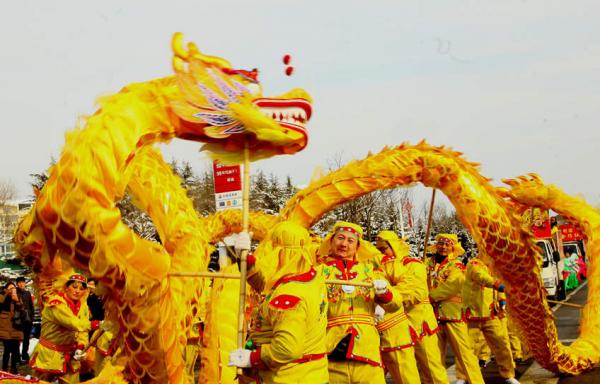
From the Han and Tang Dynasty to the Ming and Qing Dynasties, there are numerous records of dragons on the historical books. Up to now, there are still folk customs of dragon dance to pray for rain. During every traditional Chinese festival such as Chinese New Year, Lantern Festival, there are dragon dances in different styles all over China - the giant gorgeous painted dragon, the "Baiye dragon" composed with hundreds of blossoming lotus, the "fire dragon" full of incense and with mouth breathing fire, "the human body dragon", "bench dragon", "hand dragon" and so on. Dragon dance has become the symbol of Chinese national spirit.
Lion Dance
The lion dance is one of the most reprehensive traditional Chinese dances and one of the most distinctive Chinese cultural arts. It is often mistakenly referred to as dragon dance. An easy way to tell the difference is that a lion is operated by two people, while a dragon needs many people. Also, in a lion dance, the performers` faces are covered, since they are inside the lion. In a dragon dance, the performers can be seen since the dragon is held upon poles.
Basic lion dance fundamental movements can be found in most Chinese martial arts. It brings good fortune. The lion dance is usually performed by group of two or three people. One is at the head and one is at the tail of the lion. The third person usually wears a mask and acts as the “Happy Buddha”.
Lion dances can be categorized into two styles, Chinese Northern and Chinese Southern.
In northern dance, the lion is usually red, orange and yellow, shaggy in appearance with big golden head; The Chinese Northern dance was used as entertainment for the imperial court and elsewhere with dangerous stunts.
The Chinese Southern dance is more symbolic which usually performed as a ceremony to scare away evil spirits and to summon luck and fortune. The southern lion exhibits a wide variety of color and has a distinctive head with large eyes, a mirror on the forehead, and a single horn at center of the head. Lion dance costumes are considered to be spiritually protective when used as they are traditionally blessed before usage.
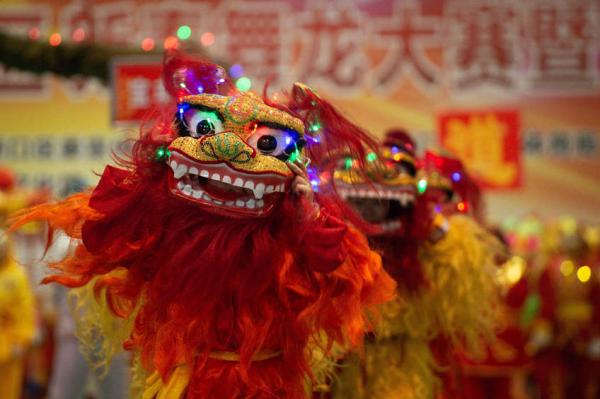
Traditional Chinese Ribbon Dance
The traditional Chinese ribbon dance is a classical Chinese dance dated back to the Tang dynasty in the early eighth century. It has been attributed to Emperor Tang-Ming-Hwon and his consort Yang-Gwei-Fei for their musical and dancing talent respectively. The Chinese legend has it that Emperor Tang-Ming-Hwon (Tang Xuanzong) once dreamed that he was in the moon palace with many fairies singing and dancing in multicolored cloud-like long robes. The dance with the flowing silk ribbons and accompanied by Chinese music instruments- Erhu and Pipa is characterized by its refreshing and poetic mood. "The Dance of Nei Chang Yu Yi" (Rainbow and Feather Dress Dance) therefore was created, and can be performed in the form of solo, pas de deux and group dance. The dancers hold Fanjie (幡节), wore feathered dance dress and emeralds. When they danced, they were like a group of cranes flying in the sky. It is a reserved program of the Tang Dynasty, and also a masterpiece works of the traditional Chinese dance.
Yangko Dance
The Yangko dance is a traditional Chinese folk dance. The dance is smooth and compact in rhythm, featuring its jolly scene, abundant dance language, exuberant gestures, and vivid performing style. The Yangko dance was created by the farmers when they worked in the rice field in the Song Dynasty, and is used to worship god of farming to pray for harvest in ancient times. Year after year, the Yangko dance constantly absorbed techniques and forms from farming songs, folk songs, folk Kungfu, acrobatics and dramas. Because of the differences of regions and customs, some variations exist in the Yangko dances. There are three types of performance in Chinese Yangko dance: the song-and-dance duets, Yangko performed on the ground and Yangko preformed on the stilts. Yangko dance costumes, a kind of traditional Chinese dance performance costumes, are colorful and gorgeous, made mainly based on the theatrical costumes.
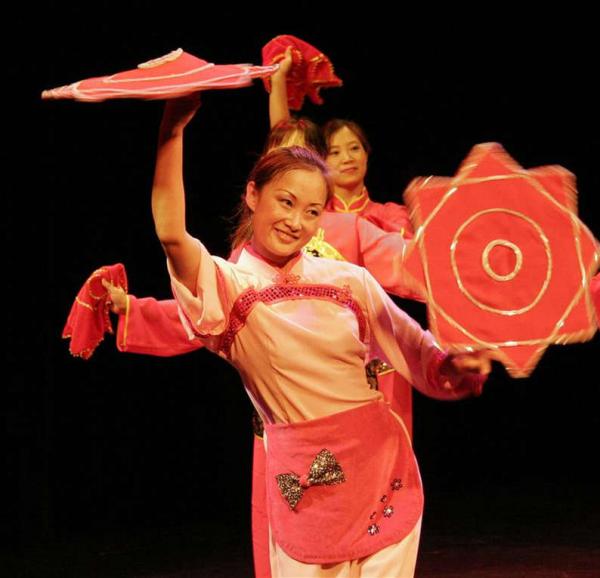
Traditional Chinese Fan Dance
Fan dance generally refers to the dance with the fan as the main prop. It is one of the traditional styles of Chinese folk dance. The Han, Hani, Korean and other ethnic groups have formed their own fan dance styles. Hani fan dance is divided into brown fan dance and paper fan dance, and popular in Honghe, Yuanjiang, Xinping, Yuanyang counties of Yunnan Province.
The brown fan dancers are mostly women. They use Japanese banana leaf or palm leaf fans to simulate the life, posture and moves of the silver pheasant. The dance is gentle and solemn, showing worship for the grandmother of the village god, expressing the good wishes and ideals of the Hani people. The paper fan dance is an evolution of the brown fan dance. It is mainly performed by men during funerals. The dance can be performed by two, four or many people in pairs. The dance music rhythm is slow and most of the dance mimics the movements of birds.
Korean fan dance originated from the Korean tradition of witchcraft and later developed into a form of performance dance. Korean fan dance is usually performed by women, who express their inner joy by waving their fans. It shows the unique rhythm of the Korean nationality, the inner emotions, and the curvilinear rhythm.
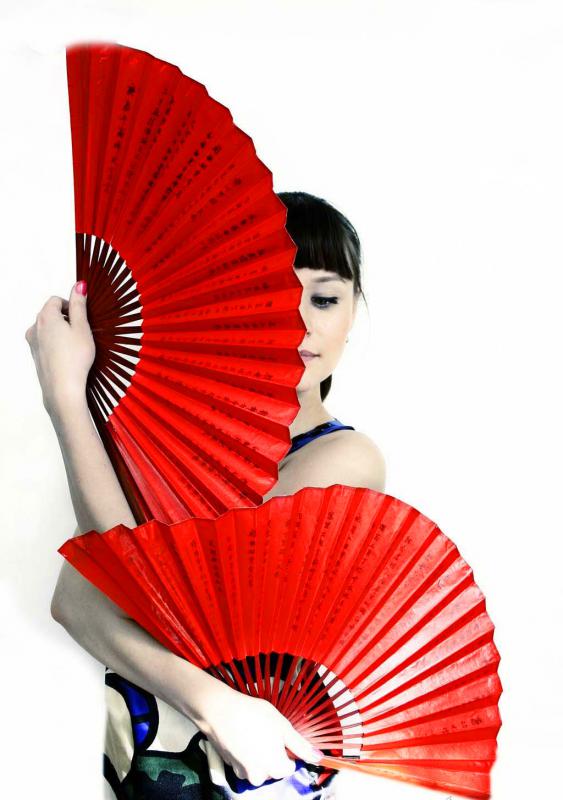
Traditional Chinese peacock dance
Peacock dance, the most famous traditional dance performance of Dai people, is popular in Ruili, Luxi and Xishuangbanna in Dehong Dai and Jingpo Autonomous Prefecture, Yunnan Province. Legend has it that over a thousand years ago, Dai leader Zhaoma LiJiesu learned to dance by imitating the graceful posture of peacocks. Later, the dance moves were processed by generations of folk artists, and passed down to form the peacock dance today.
The movements of peacock dance are graceful, flexible, light and agile. It has the following characteristics: 1) It is manifested by a flexible rise and fall in the knee; 2) The characteristics of peacock dance are also shown through the soft and firm changing of arms, wrists and fingers; 3) Peacock dance moves require speed and agility on calf, and eye flexibility.
Yang Liping is the most famous peacock dancer. Her master works "Spirit of the Peacock" and "Love of the Peacock" are modern dances that absorb the characteristics of the traditional peacock dance, but are quite different from the traditional peacock dance in terms of costume and performance.
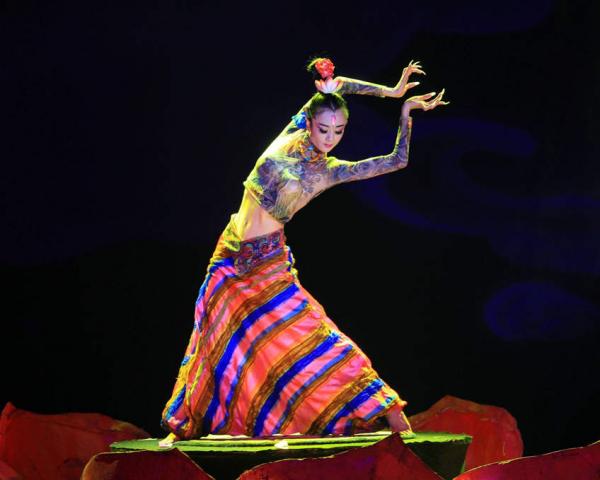
Chinese traditional long sleeves dance
Long sleeves dance is one of the four great effects of Chinese Peking Opera, it blends the characteristics of both opera and dance, showing a unique beauty. Originated in ancient Chinese dance, long sleeves dance was very popular as early as the Han and Tang dynasties. This dance form pays attention to body rhyme, swaying posture, unique verve, and special technique charm.
